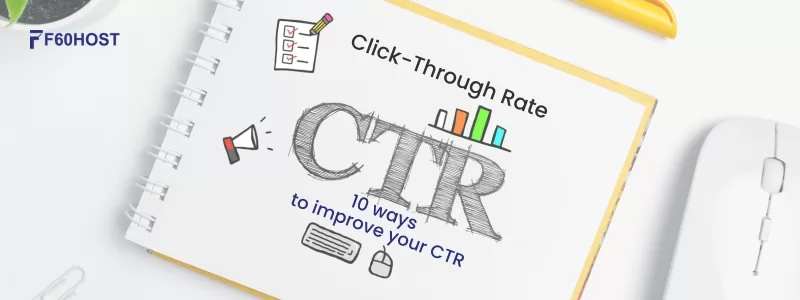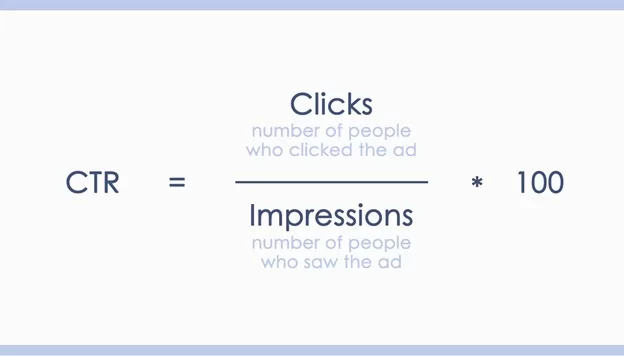Click-Through Rate: 10 Ways to improve your CTR
The click-through rate (CTR) is the ratio of clicks on your link to the number of times your listing appeared on a SERP (impressions). This article will teach you more about the click-through rate and the 10 tried-and-true tips for increasing it. But first, let’s see what CTR is, why it’s important, and see what your ideal CTR should be.

What does Click-Through Rate mean?
CTR is a ratio that is determined by the ratio of views to clicks on an advertising website or its search snippet. The higher the CTR showings are, the more web users will click on the website ad or Google snippet.
Users who click on a search engine result are said to have an organic click-through rate. Your URL would be the outcome in this situation. While the ranking position is the main determinant (the more people who see your content, the more likely it is that they will click), a number of other factors can also have an impact.
Your Google ranking can be raised if you concentrate your efforts on increasing organic CTR. When a URL receives a lot of traffic, search engine algorithms will view it as valuable and pertinent for subsequent queries containing the keywords in your content.
What Is CTR in SEO?
CTR is important in SEO for both paid and organic search engine optimization campaigns. There is still debate about the relationships between click-through rates and rankings.
Click-Through Rate in SEO is primarily determined by the site’s ranking position (which you can find in tools like Ahrefs or SEMRush, or other SEO rank trackers). However, the metadata (title, description), URL, and presence of Rich Snippets all have an impact on organic click-through rates. Many SEO tools, some free and many affordable, can assist you in determining this.
What does an average CTR mean?
You’re probably wondering what an average CTR is when trying to figure out if your Click-Through Rate is good or bad. To put it simply, it is the number of clicks on your site divided by the number of times it is displayed.
The click-through rate formula could be presented as follows:
CTR = (number of clicks/number of views) х 100

For example, if your Click-Through Rate is 5%, that means 5 out of every 100 people click through to your website.
According to a DataBox survey, the majority of website owners have a CTR of 3-5%. This is the average performance of Internet web pages.
Organic click-through rates are high in less than 5% of respondents (16%-21% and higher). A healthy organic CTR is +10%. It is possible to increase the click-through rate of the web resource, improve its SEO performance, and hit top SERPs in Google by using optimized snippets and other elements such as URL, metadata, and supplementary components visible to users such as site links, ratings, and imagery.
Comparing your site’s CTR to a generic benchmark is not very helpful because it can vastly differ from industry to industry. Using the average CTR above as a general frame of reference is fine, but you’ll want to update your benchmark once you dig into your webpage’s statistics.
10 Ways to Increase Organic CTR:
As we have seen, high rankings do not guarantee that users will visit your website. It takes a little more skill.
Follow these 10 tips if your page ranks on the first page but has a lower CTR than expected.
- Match the title tag to the H1 tag: Using long-tail keywords in your headings and title tags is one of the first ways to increase your organic Click-Through Rate. Long-tail keywords are highly descriptive, which matches your content to search intent.
According to Ahrefs’ analysis of 953,276 pages, Google rewrites title tags 33.4% of the time.
They also discovered that if your title tag matches the H1 tag on the page, Google is less likely to change it in the search results. So, search engines (and people) prefer that the title and H1 tag on the page reflect the content of the article, so they should match.
- Create Powerful Meta Titles and Descriptions: Writing effective meta descriptions is another strategic way to boost your organic CTR. These are the text snippets that appear in the SERPs beneath your title tag. A good meta description tells users what your page is about and entices them to click through to your post.
Once again, your keywords will come in handy. Use them to show users that your article solves a problem for which they are looking for solutions. Other ways to improve your meta description include answering questions, making the meta titles and descriptions specific and relevant, and using solid and compelling language.
- Add schema markup for more detailed results: Structured data is an excellent way to “speak” to search engine algorithms. You can accomplish this by converting your content into code that search engines can easily process using Schema.org. This will enable them to present rich, interactive search results. These are commonly referred to as rich snippets.
Naturally, this type of search result generates more clicks because they appear at the top of the search engine results pages, they’re more appealing than plain URLs and they provide additional information about the content at a glance. People love interactive content, so implementing structured data will increase your organic CTR rates.
- Make Image-Based Posts: It’s common practice to include images in posts, but did you know that doing so can increase your organic CTR? Including images in your content is a great way to increase engagement. They are a necessary component for your content to show up in info boxes and featured snippets on search engine results pages (SERPs).
Additionally, it increases the likelihood that users will click on your URL when they look for search results in the images section. You must use image SEO best practices, such as giving your images appropriate names and adding alt text, for this to work.
- Make Use of Descriptive URLs: Your page URL is one of the most important pieces of information displayed on SERPs. As a result, you must optimize it in order to improve your organic CTR. One way to accomplish this is to make it as descriptive as possible.
In your URL, try to naturally include your keyword. This will support the main idea of your post and demonstrate to readers the value of your information. Keep it short as another recommendation for URL optimization. This both makes it more aesthetically pleasing and appealing. It will therefore receive more clicks as a result. You can modify your URL in your permalink settings if you use WordPress.
- Align with search intent: The reason behind a search is known as search intent. Why did this user conduct this search? What do they hope to discover?
Because your search listing is the first thing people see, it must convey how your page completely answers the user’s query. To better connect with the audience, we can modify our titles with keyword modifiers and write meta descriptions so that your entire SERP snippet aligns with the search intent.
- Improve Site Speed: Site speed has never been more important, with Google prioritizing Page Experience and Web Core Vitals as ranking factors.
If your website isn’t optimized for speed, people may click on your link but then leave, lowering your organic CTR. To put it into perspective, a one-to-three-second increase in site speed increases bounce rates by 32% on mobile devices.
- Use Rich Snippets: As previously mentioned, rich snippets are another way to drive traffic to your website. These are search results with data accompanying them.
The only ways to display those reviews and ratings in search results are to (A) activate a rich snippet plugin or (B) manually code it. The additional information (for example, ratings) assists users in deciding whether or not to click on your URL.
- Try to avoid being cut off due to pixel length: To avoid being cut off in search engine results, page titles should be less than 580 pixels (about 50-60 characters). This length ensures that your page titles are fully visible on both desktop and mobile.
- Create High-Conversion Landing Pages: Landing pages are a critical component of any digital marketing strategy. After all, well-designed websites are a great source of traffic. To ensure that your landing pages are successful, you should:
- Understand landing page elements like a clear and concise headline, high-quality images, well-produced videos, persuasive copy, and calls to action.
- Optimize for UX to provide a positive user experience by ensuring that the landing page loads quickly and is easy to read.
This will almost certainly increase conversions and improve click-through rates.
Conclusion – The Significance of CTR in SEO and How to Determine Which Pages to Optimize for CTR:
CTR is not a ranking factor in and of itself. However, it is extremely important for your SEO performance. The higher your organic click-through rate, the more leads you can convert into long-term clients. The first page of search results is important, but there is more to think about. It is critical to strike a balance between SEO and CTR optimization.
How to Determine Which Pages to Optimize for CTR:
Just as you don’t want to analyze CTR from a general point of view, you don’t want to optimize for CTR as a sitewide sweeping action.
To find what pages to optimize Click-Through Rate for, sign in to Google Search Console, select your search property, and open the Performance > search results report.
The date range will be set to the last three months by default. This is acceptable, but feel free to adjust the time to accommodate for site volume and seasonality.
Choose only the scorecards for “total impressions,” “average CTR,” and “average position” by clicking. By clicking on the “+” sign with the text “New,” you can add filters to drill down to your target country (and content topic). You’re looking for a trend or a useful keyword for your brand.
We want to see an upward (or stable) trend in search volume and a healthy number of clicks going to organic results (click distribution). Because there’s no point in prioritizing a page that rarely results in organic clicks. Investing time and resources in improving Click-Through Rate for this webpage will likely increase site traffic.
Naturally, Click-Through Rate is significant because a higher CTR results in increased website traffic and since they are one step closer to becoming customers, we appreciate it when people visit our website. CTR is beneficial from a tactical perspective as well. It can be used to prioritize content optimization and forecast the traffic that increases in organic search will bring.
For entrepreneurs who sell their products and services online, click-through rates and website search positions are critical. Use the best CTR optimization methods and tools such as Google Search Console, Ahrefs, etc to outperform competitors and increase organic traffic.
Enjoyed this blog? Then be sure to visit F60 Host for more SEO related articles.
